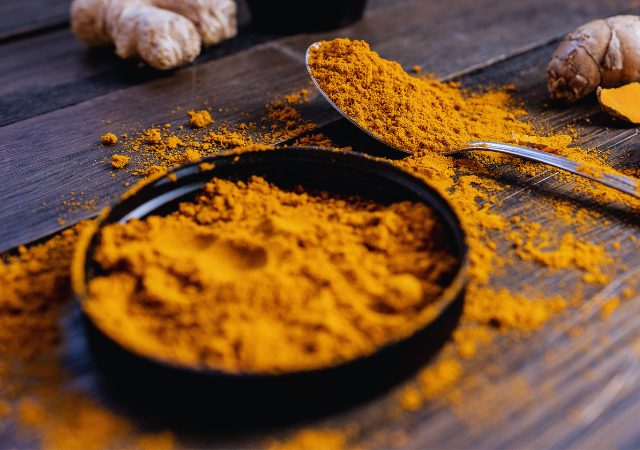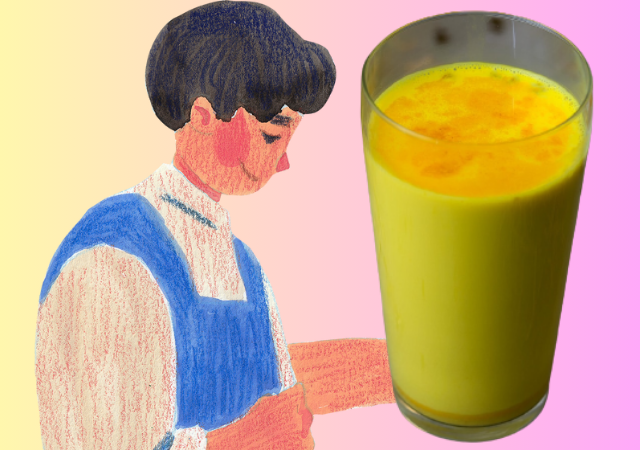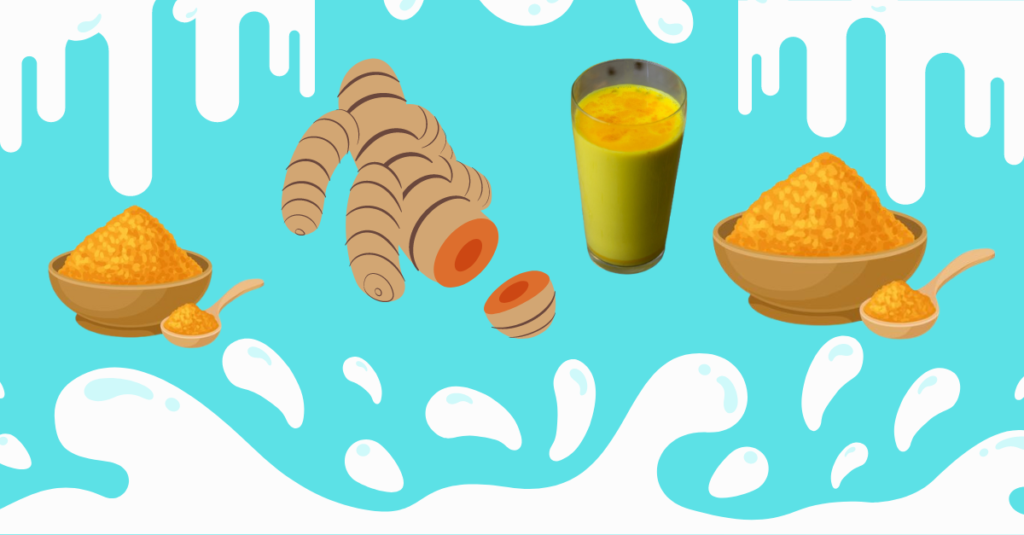Is Drinking Milk with Turmeric Good for the Skin?
In our quest for beautiful, radiant skin, the beauty industry is flooded with products promising the ultimate solution. From serums to creams and cleansers, we often forget that nature holds its own arsenal of skincare wonders. One such natural remedy that has been gaining traction in recent years is the combination of milk and turmeric. It might sound unconventional, but advocates of this homegrown elixir claim it can work wonders for your skin. So, is drinking milk with turmeric truly a pathway to healthier, more beautiful skin? In this article, we’ll explore the science behind this intriguing blend and examine the potential benefits it offers for your skin health.
-
The Science Behind Turmeric

Before we dive into the potential benefits of drinking milk with turmeric for your skin, let’s take a moment to understand the science behind turmeric itself. At the heart of this vibrant yellow spice lies a potent compound called curcumin. Curcumin is responsible for many of turmeric’s reputed health benefits.
Antioxidant and Anti-Inflammatory Properties:
Curcumin is celebrated for its robust antioxidant and anti-inflammatory properties. Antioxidants help combat the harmful effects of free radicals in our bodies, which can damage cells and accelerate aging. By neutralizing these free radicals, curcumin aids in maintaining skin health and youthful appearance.
Furthermore, its anti-inflammatory attributes have made curcumin a subject of extensive research in various fields, including dermatology. Inflammation plays a pivotal role in numerous skin conditions, such as acne, eczema, and psoriasis. Curcumin’s ability to suppress inflammatory pathways suggests its potential to alleviate the redness, swelling, and discomfort associated with these conditions.
Historical Uses of Turmeric in Skincare:
Turmeric’s skincare lineage is deeply rooted in traditional medicine systems such as Ayurveda and Traditional Chinese Medicine (TCM). For centuries, it has been applied topically to treat various skin ailments, ranging from cuts and burns to chronic conditions like psoriasis.
These historical uses serve as a testament to the trust placed in turmeric’s therapeutic properties for skin health. However, the question remains: can the incorporation of turmeric into our diets, specifically in combination with milk, provide comparable benefits?
-
Milk and Its Role in Skin Health

Before exploring the synergy between milk and turmeric, it’s essential to understand the individual contributions of milk to skin health.
1. Nutritional Components:
Milk is a rich source of essential nutrients, some of which are beneficial for the skin:
- Lactic Acid: Lactic acid, a natural alpha hydroxy acid (AHA) found in milk, acts as an exfoliant and helps remove dead skin cells, promoting a brighter complexion and smoother texture.
- Calcium: Calcium plays a vital role in regulating skin cell differentiation and proliferation, contributing to the overall health of your skin.
- Vitamin D: This sunshine vitamin is necessary for various bodily functions, including skin health. Adequate vitamin D levels support skin barrier function and may help alleviate skin issues like eczema.
2. Hydration:
Proper hydration is crucial for maintaining healthy skin. Milk contains a high percentage of water, which can help keep your skin hydrated from the inside out.
-
Benefits of Drinking Milk with Turmeric for the Skin

Now that we have a foundational understanding of both turmeric and milk, let’s explore the potential benefits of combining them for the sake of your skin.
1. Anti-Inflammatory Effects:
One of the most significant advantages of this combination is its potential to reduce inflammation in the body. Chronic inflammation is a common factor in many skin conditions, including acne, rosacea, and eczema. By consuming turmeric, which contains curcumin, alongside milk, you may help calm your skin from within.
The anti-inflammatory properties of curcumin can aid in reducing redness, swelling, and irritation associated with these skin conditions. Some individuals have reported noticeable improvements in the appearance and discomfort of their skin after incorporating this blend into their daily routines.
2. Antioxidant Protection:
Both turmeric and milk offer antioxidant protection to your skin cells. As mentioned earlier, antioxidants combat free radicals, which can damage collagen, elastin, and other vital components of your skin. By preventing this damage, you can potentially delay the signs of aging, such as fine lines and wrinkles.
3. Lightening and Brightening:
Turmeric has a reputation for its skin-brightening properties. It may help reduce hyperpigmentation, dark spots, and uneven skin tone when consumed regularly. While topical turmeric masks are commonly used for this purpose, incorporating it into your diet through milk may provide a more systemic and long-term approach to achieving a radiant complexion.
-
How to Prepare and Consume Milk with Turmeric

To reap the potential benefits of drinking milk with turmeric for your skin, you’ll need to prepare this blend correctly and consume it regularly. Here’s a simple recipe to get you started:
Ingredients:
- 1 cup of milk (dairy or non-dairy)
- 1/2 to 1 teaspoon of turmeric powder (adjust to taste)
- A pinch of black pepper (optional, as it enhances curcumin absorption)
- Honey or a sweetener of your choice (optional, for taste)
Instructions:
- Heat the milk in a saucepan until it’s warm but not boiling.
- Add the turmeric powder and black pepper (if desired).
- Stir well to ensure the turmeric is fully dissolved.
- Simmer for a few minutes, stirring occasionally.
- Remove from heat and allow it to cool slightly.
- Optionally, sweeten with honey or your preferred sweetener.
- Drink this turmeric milk daily or a few times a week for best results.
Important Notes:
- If you’re new to consuming turmeric, start with a smaller amount (1/2 teaspoon) and gradually increase it to gauge your tolerance.
- Some individuals may experience digestive discomfort when consuming turmeric. If this happens, reduce the amount or consult with a healthcare professional.
-
Scientific Studies and Research
While the potential benefits of drinking milk with turmeric for skin health are promising, it’s essential to acknowledge that scientific research on this specific combination is limited. Most studies have focused on the topical application of turmeric or curcumin-based creams and ointments for skin conditions.
However, there is substantial evidence supporting the individual benefits of both turmeric and milk for overall health. Curcumin, in particular, has been extensively researched for its anti-inflammatory and antioxidant properties, which could indirectly benefit the skin.
-
Other Uses of Turmeric for Skin
While this article primarily focuses on the consumption of turmeric for skin benefits, it’s worth noting that turmeric has a long history of use in topical skincare as well. Turmeric face masks and skincare products are popular for their potential to brighten the complexion, reduce acne, and soothe irritated skin. Integrating both internal consumption and external application of turmeric into your skincare routine may yield comprehensive results.
Conclusion
In the pursuit of healthier, more radiant skin, exploring natural remedies like drinking milk with turmeric can be an exciting journey. The science behind the potential benefits of this combination, including its anti-inflammatory and antioxidant properties, holds promise for individuals seeking a holistic approach to skincare.
However, it’s essential to approach such remedies with a balanced perspective. While there is no doubt that milk and turmeric offer various health benefits, individual results may vary. A combination of factors, including genetics, overall skincare routine, and lifestyle choices, contributes to skin health.
Before making any significant dietary changes or incorporating new ingredients into your regimen, it’s advisable to consult with a dermatologist or healthcare professional. They can provide personalized guidance based on your unique skin type and any specific skin concerns you may have.
In the end, achieving beautiful, healthy skin involves a combination of factors, from a balanced diet to proper hydration, effective skincare, and lifestyle choices. While drinking milk with turmeric can be a valuable addition to your routine, it’s just one piece of the puzzle on your path to glowing skin.

My name is Rohit Vagh and I’m a content writer specializing in fashion and lifestyle. I have three years of experience in this field and have written various articles. My writing style is creative and engaging, and I strive to create content that resonates with my readers. I have a deep passion for fashion and am constantly researching the latest trends and styles to make sure my readers are up to date. I’m excited to continue my career in blogging, and I’m always looking for new opportunities in the fashion and lifestyle space.





